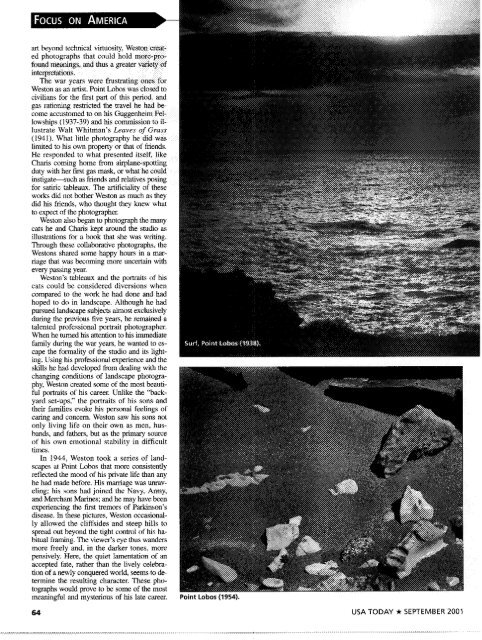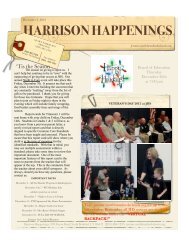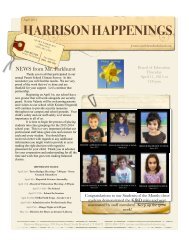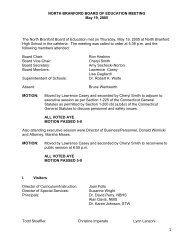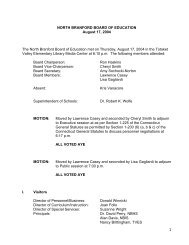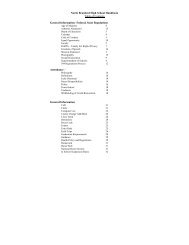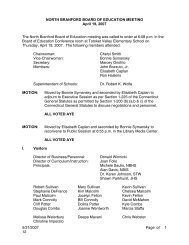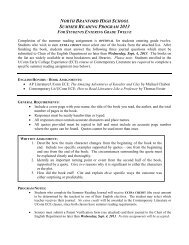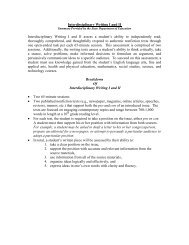<strong>Edward</strong> <strong>Weston</strong>:The Last YearsTBY DAVID TRAVIS". . . As he developed his art beyond technicalvirtuosity, <strong>Weston</strong> created photographs thatcould hold more-profound meanings, and thusa greater variety of interpretations. "HE LATER PART of an artist's careercan be a private realm and itswork difficult to appreciate if oneT demands that art must always communicateone sensibility to another. Olderartists who once expounded their ideas to thewide world often tum quietly inward to examinewhat the creative life means not to theircontemporaries, but to themselves.The last decade in which <strong>Edward</strong> <strong>Weston</strong>(1886-1958) was active as aphotographerprimad,lytook place at Point LAobos, his favoritelandscape on the central Califomia coast, andat his home in the Carmel Highlands. <strong>Weston</strong>was a formalist, world fanous for his virtuosityin making objective and exquisite views ofnatural shapes and pattems. By 1944, however,he had transformed himself into a man capableof making his own life experience thecompelling subject of his art.That change in <strong>Weston</strong>'s work previouslyhad been invisible to most admirers andscholars because it was subtle and his subjectsstill primrtily natural objects and nudes. Theshift was undeclared as well because, atter1934, he no longer made entries in his Davbooks,where he had articulated his thoughtsabout the medium. One might say that thepensive and more-somber character that hisphotographs from 1944 to 1948 emote is theresult of the tensions of his dissolving marriage,the entry of all four of his sons into themilitary, and the onset of Parkinson's disease.Ihe more introspective nature of much of hislate work is also something that is possiblewith great artists who draw upon their wealthof personal experience in the last years oftheir creative activity.Seen from these two perspectives, <strong>Weston</strong>'stransformation, accomplished in the face ofintractable adversities, becomes not a depressingtale, but, rather, a heroic one of perseverance,acceptance, and fulfillment. It is one ofthe inspiring stories in the history of Americanart to which the relatively little-knownworks of his last 10 years powerfully attest.In May, 1938, <strong>Weston</strong> moved into a newstudio in the Carmel Highlands with hisyoung model, muse, professional partner, andwife-to-be Charis Wilson. He had just completedthe most productive year of his careerto date. An I 1-month tour of Califomia as aGuggenheim Fellow had provided him withample opportunity to develop his natural stilllifes into sophisticated compositions of vistas,clouds, and lanidscape patterns. To break upthe routine of puinting hundreds of negativesin his new darkroom, he began to revisit nearbyPoint Lobos, his favorite landscape. Forthe first time, he photographed the dynanicocean surf in its various shapes and tones. Thefluid forms of rocks and seaweed attracted hiseye with new meaning. lie also studied stnsetsand the tonal values that emerged fromsummer fogs, two elements he had once consideredtoo scenic for the modernist photographerhe felt himself to be. Suddenly, at the ageof 52, <strong>Weston</strong> found that the world seemednew again and his life as an artist full of possibilities.Just one year after <strong>Weston</strong>'s photographicrediscovery of Point Lobos, his work changedagain. He had begun to venture beyondrecording the objects and atmospheres of thepristine headland in their plain, factual phvsicality.Increasingly, his photographs suggestedmoods. His images of cypress trees andtide-pool rocks struck some viewers aspainful, tortured shapes, or the tonality of acalm sea after a storm as sad. In addition tosuch psychological readings, <strong>Weston</strong>'s photographsin 1939 and 1940 began to reveal anew level of compositional complexity. Thepresentation within a single frame of masculineand feminine elements, oppositions oflight and dark, and symbols of life and deathenriched the photographs.l)uring World War 11 and after, the metaphoricalpotential of <strong>Weston</strong>'s work allowedothers to see even the most-abstract still lifesas scanred battlefields and sandstone erosionsas disoriented characters. The photographerstated, however, that he never intended suchmeanings. Nonetheless, as he developed hisUSA TODAY * SEPTEMBER 2001 63- 1.1 .1___.- 1- - -----____ ___ ...._.-
8 6 :art beyond technical virtuosity, <strong>Weston</strong> createdphotographs that could hold more-profoundmeanings, and thus a greater variety ofinterpretations.The war years were frustrating ones for<strong>Weston</strong> as an artist. Point Lobos was closed tocivilians for the fust part of this period, andgas rationing restricted the travel he had becomeaccustomed to on his Guggenheim Fellowships(1937-39) and his commnission to illustrateWalt Whitman's Leaves of Grass(1941). What little photography he did waslimited to his own property or that o friends.He responded to what presented itself, likeCharis coming home from airplane-spottingduty with her first gas mask, or what he couldinstigate-such as friends and relatives posingfor satiric tableaux. The artificiality ol' theseworks did not bother <strong>Weston</strong> as much as theydid his friends, who thought they knew whatto expect of the photographer.<strong>Weston</strong> also began to photograph the matycats he and Charis kept around the studio asillustrations for a book that she was writing.Through these collaborative photographs, the<strong>Weston</strong>s shared some happy hours in a marnagethat was becoming mnore uncertain withevery passing year<strong>Weston</strong>'s tableaux and the portraits of hiscats could be considered diversions whencompared to the work he had done and hadhoped to do in landscape. Although he hadpursued landscape subjects almost exclusivelyduring the previous five years, he renained atalented professional portrait photographer.WN hen he turned his attention to his immediatefamily during the war years, he wanted to escapethe foniality of the studio and its lighting.Using his professional experience and theskills he had developed from dealing with thechanging conditions of landscape photography,<strong>Weston</strong> created some of the most beautifulportraits of his career. Unlike the "backyardset-ups." the portraits of his sons andtheir famnilies evoke his personal feelings otcaring and concem. <strong>Weston</strong> saw his sons notonly living life on their own as men, husbands,and fathers, but as the primarv sourceof his own emotional stability in difficulttunes.In 1944, <strong>Weston</strong> took a series of landscapesat Point Lobos that more consistentlyreflected the mood of his private life than anyhe had made before. His marriage was unraveling;his sons had joined the Navy, Army,and Merchant Marines; and he may have beenexperiencing the first tremors of Parkinson'sdisease. hi these pictures, <strong>Weston</strong> occasionallyallowed the cliffsides and steep hills tospread out beyond the tight control of his habitualframing. The viewer's eye thus wandersmore freely and, in the darker tones, inorepensively. Here, the quiet lamentation of anaccepted fate, rather than the lively celebrationof a newly conquered world, seems to deteriTnethe resulting character. These photographswould prove to be some of the mostmeaningful and mysterious of his late career. Point Lobos (1954).64USA TODAY * SEPTEMBER 2001


